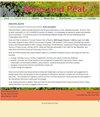Ecohydrology and causes of peat degradation at the Vasi peatland, South Africa
IF 1.5
4区 环境科学与生态学
Q4 ENVIRONMENTAL SCIENCES
引用次数: 1
Abstract
The Vasi peatland complex is situated in the northeast of South Africa. It is an unprotected area surrounded by pine (Pinus sp.) and blue gum (Eucalyptus sp.) plantations. Little is known about the conditioning factors for the area’s development and causes of degradation. In order to understand the ecohydrological system of this complex, water tables and ionic composition of surface water and groundwater, as well as natural isotopes of oxygen, hydrogen and carbon, were measured. Macrofossils and radiocarbon dating of the peat layer were used to describe the historical environmental conditions. We found that peat accumulation started during the Early Holocene and was initiated by terrestrialisation of inter-dune lakes. Our results also show that the Vasi peatland complex is primarily dependent on a perched water table due to the presence of iron-rich deposits close to the surface (i.e. KwaMbonambi Formation). The Vasi peatland basins appear to be hydrologically connected and some basins show indications of cascading through-flow systems, which means that the water flows from a higher basin to a lower one through the permeable parts of the sand dunes and peat layers. The stratigraphy indicates continuous peat accumulation, and thus that the water table was perennially high for thousands of years, despite evidence of the occasional natural occurrence of fires. We conclude that the most likely cause of the observed signs of degradation is land use change, i.e. the recent establishment of plantations, which affect the groundwater system.南非Vasi泥炭地泥炭退化的生态水文和原因
瓦西泥炭地位于南非东北部。这是一个被松树(Pinus sp.)和蓝桉树(Eucalyptus sp.)种植园包围的未受保护的地区。人们对该地区发展的制约因素和退化的原因知之甚少。为了了解这一复杂地区的生态水文系统,测量了地表水和地下水的地下水位和离子组成,以及氧、氢和碳的天然同位素。用宏观化石和泥炭层放射性碳定年来描述历史环境条件。泥炭沉积始于全新世早期,是由沙丘间湖的陆地化引起的。我们的研究结果还表明,Vasi泥炭地复合体主要依赖于一个栖息的地下水位,这是由于靠近地表的富铁矿床(即KwaMbonambi组)的存在。瓦西里泥炭地盆地在水文上是连通的,有些盆地还显示出层叠式流系统的迹象,这意味着水通过沙丘和泥炭层的可渗透部分从较高的盆地流向较低的盆地。地层学表明泥炭不断堆积,因此地下水位几千年来一直很高,尽管有证据表明偶尔会自然发生火灾。我们的结论是,所观察到的退化迹象最可能的原因是土地利用的变化,即最近建立的人工林,这影响了地下水系统。
本文章由计算机程序翻译,如有差异,请以英文原文为准。
求助全文
约1分钟内获得全文
求助全文
来源期刊

Mires and Peat
ENVIRONMENTAL SCIENCES-
CiteScore
2.30
自引率
16.70%
发文量
0
审稿时长
33 weeks
期刊介绍:
Mires and Peat is a peer-reviewed internet journal focusing specifically on mires, peatlands and peat. As a truly “free-to-users” publication (i.e. NO CHARGES to authors OR readers), it is immediately accessible to readers and potential authors worldwide. It is published jointly by the International Peatland Society (IPS) and the International Mire Conservation Group (IMCG).
Mires and Peat is indexed by Thomson Reuters Web of Science (2017 Impact Factors: 1.326 [two-year] and 1.638 [five-year]), Elsevier Scopus, EBSCO Environment Complete, CABI Abstracts, CSA Proquest (including their Aquatic Science and Fisheries Abstracts ASFA, Ecology, Entomology, Animal Behavior, Aqualine and Pollution databases) and Directory of Open Access Journals (DOAJ). Mires and Peat also participates in the CABI Full Text Repository, and subscribes to the Portico E-journal Preservation Service (LTPA).
Mires and Peat publishes high-quality research papers on all aspects of peatland science, technology and wise use, including:
ecology, hydrology, survey, inventory, classification, functions and values of mires and peatlands;
scientific, economic and human aspects of the management of peatlands for agriculture, forestry, nature conservation, environmental protection, peat extraction, industrial development and other purposes;
biological, physical and chemical characteristics of peat; and
climate change and peatlands.
Short communications and review articles on these and related topics will also be considered; and suggestions for special issues of the Journal based on the proceedings of conferences, seminars, symposia and workshops will be welcomed. The submission of material by authors and from countries whose work would otherwise be inaccessible to the international community is particularly encouraged.
 求助内容:
求助内容: 应助结果提醒方式:
应助结果提醒方式:


